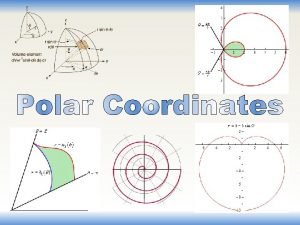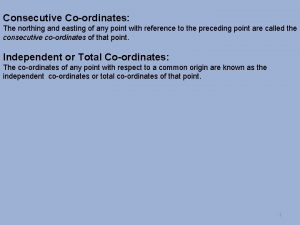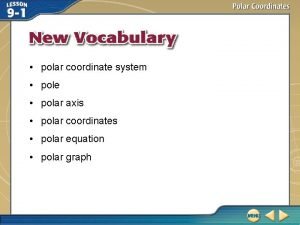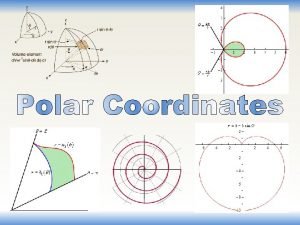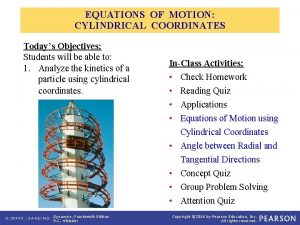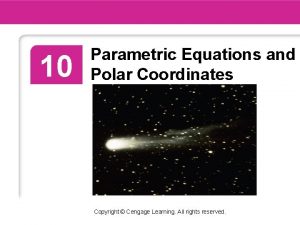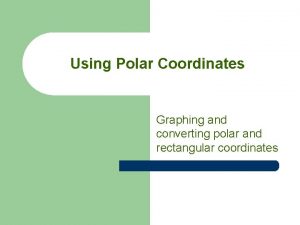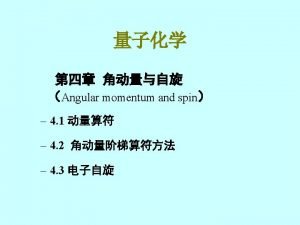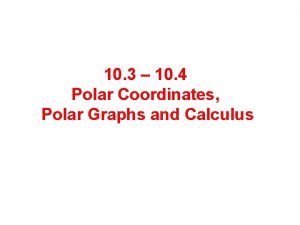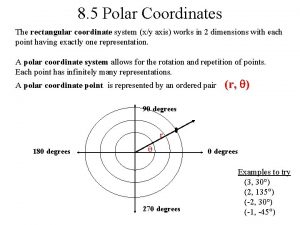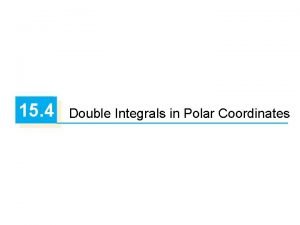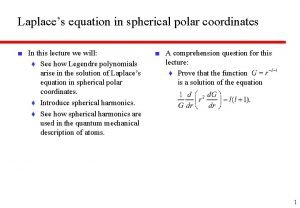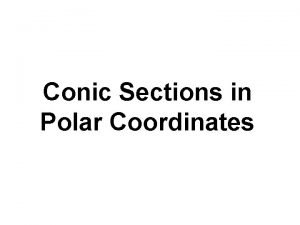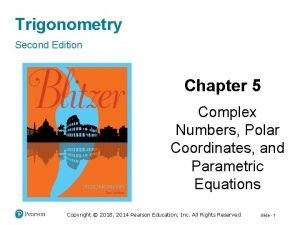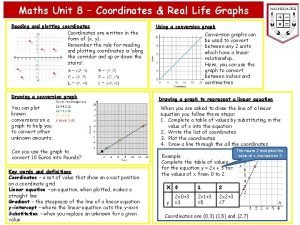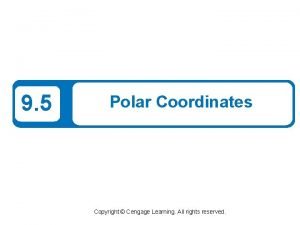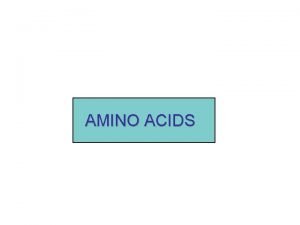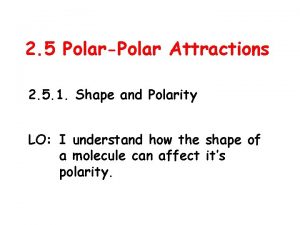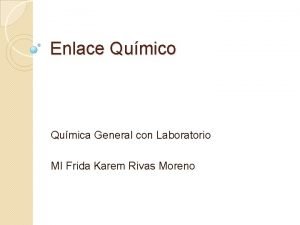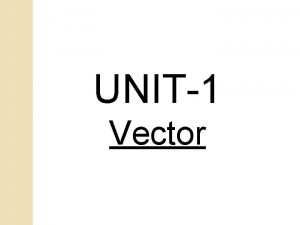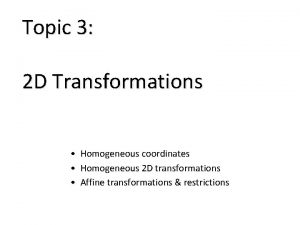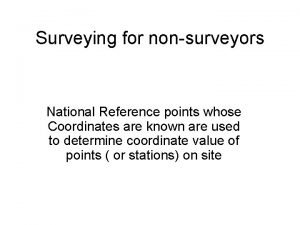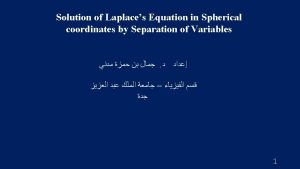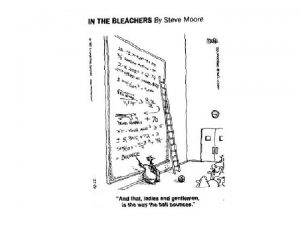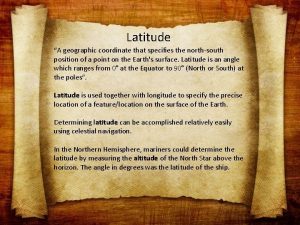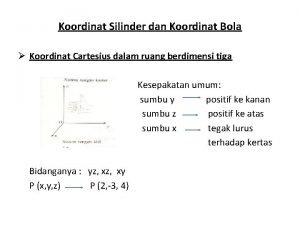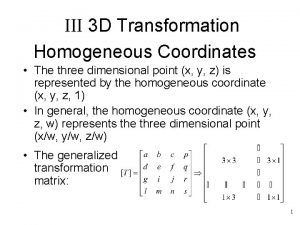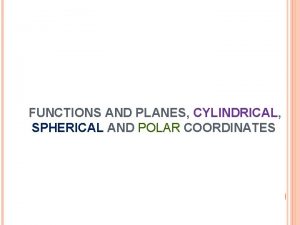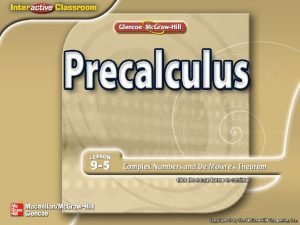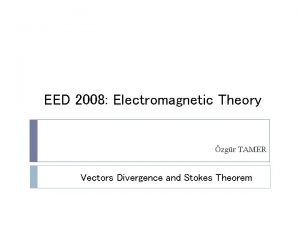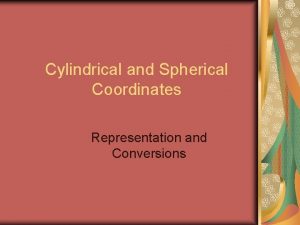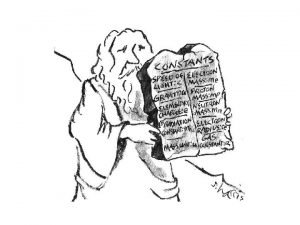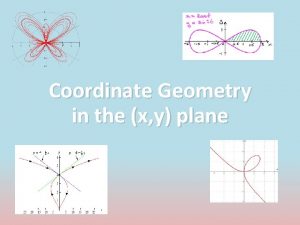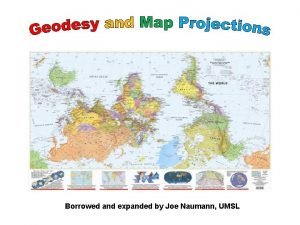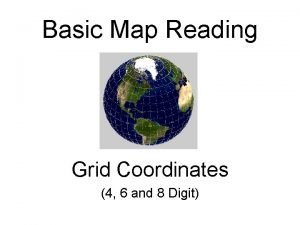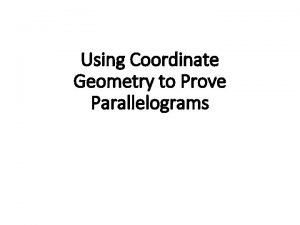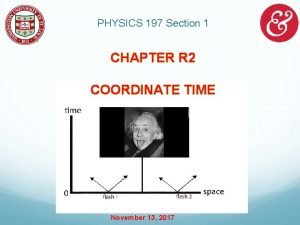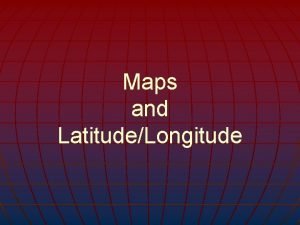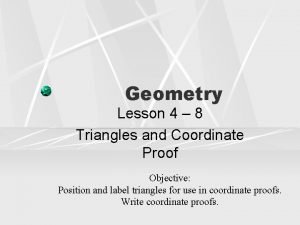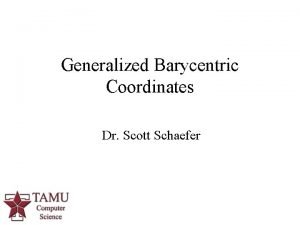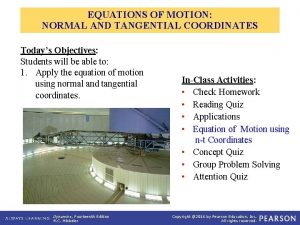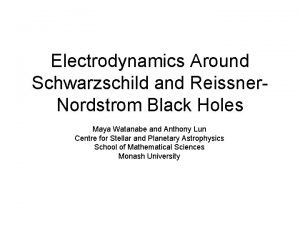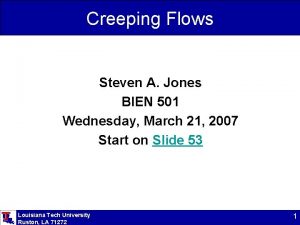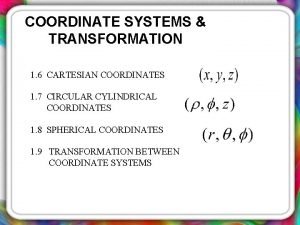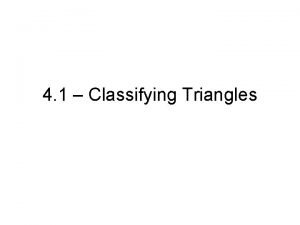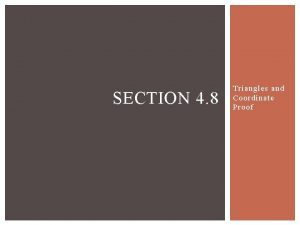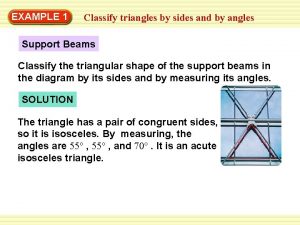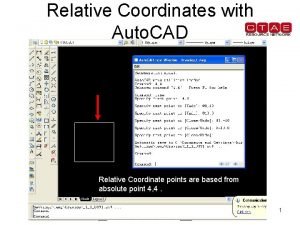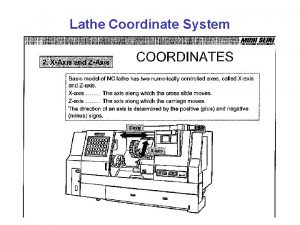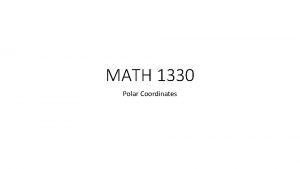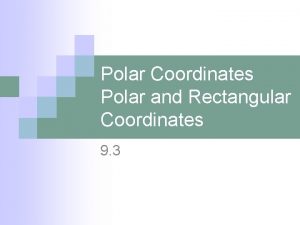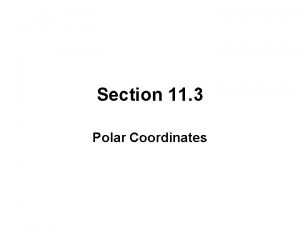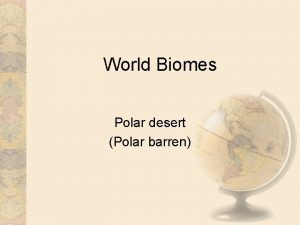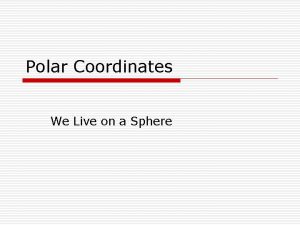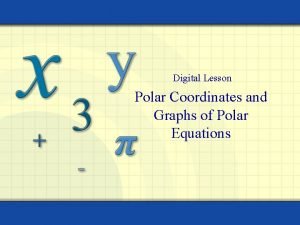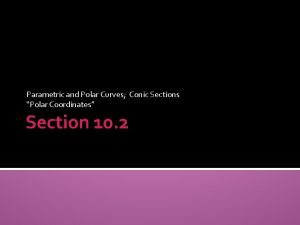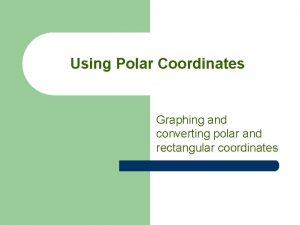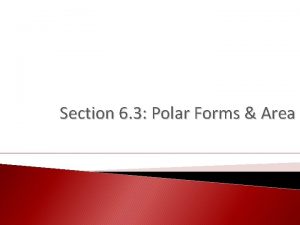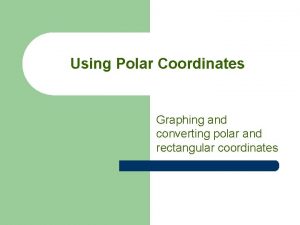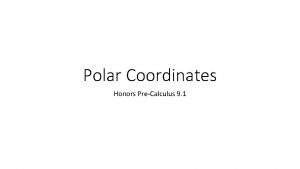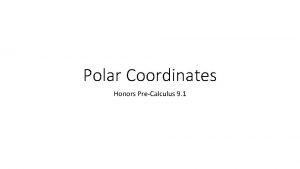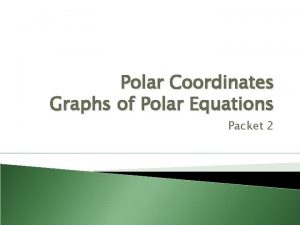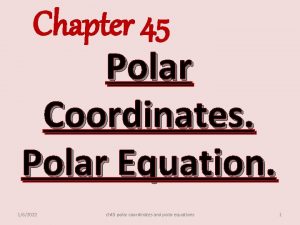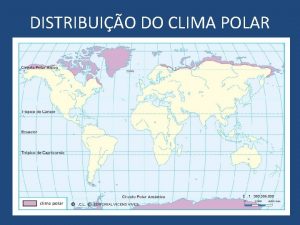Introduction Polar coordinates are an alternative system to

























































































- Slides: 89


Introduction • Polar coordinates are an alternative system to Cartesian coordinates • Some processes and equations involving the Cartesian system can become very complicated • You can simplify some of these by using Polar coordinates instead • Polar coordinates can also be used effectively to describe circular patterns, such as a moth flying towards a light, or the motion of planets, and spirals


Polar Coordinates Cartesian coordinates – use horizontal and vertical position (3, 4) You need to be able to use both Polar and Cartesian Coordinates You will no doubt be very familiar with the Cartesian way of describing coordinates using x and y as the horizontal and vertical distances from the origin Polar coordinates describe equivalent points, but in a different way Polar coordinates use the distance from the origin, and the angle from the positive x-axis You can use radians or degrees, but radians will be most commonly used in this chapter You can also use negative equivalent values for the angles (being measured the opposite way) 4 4 3 1 (-4, -1) Polar coordinates – use the distance and the angle (5, 0. 93) 5 3. 39 c 0. 93 c 4. 2 (4. 2, 3. 39) 7 A

Polar Coordinates You need to be able to use both Polar and Cartesian Coordinates You will no doubt be very familiar with the Cartesian way of describing coordinates using x and y as the horizontal and vertical distances from the origin Polar coordinates describe equivalent points, but in a different way Polar coordinates use the distance from the origin, and the angle from the positive x-axis You sometimes see Polar coordinates plotted on a Polar grid, but a Cartesian set of axes are fine as well! 7 A

Polar Coordinates (x, y) You need to be able to use both Polar and Cartesian Coordinates Hyp r You need to know some simple formulae linking Cartesian and Polar coordinates θ These come from using GCSE Trigonometry and Pythagoras… x Adj Sub in Adj and Hyp Sub in Opp and Adj Sub in Opp and Hyp y Opp Tan-1 (also known as arctan) Sub in r, x and y 7 A

Polar Coordinates Draw a diagram You need to be able to use both Polar and Cartesian Coordinates r Find the Polar coordinates of the following point: 9 θ 5 You need to find the values of r and θ Polar Cartesian Sub in x and y The Polar coordinate is then written as (r, θ) (5, 9) Calculate Sub in x and y Calculate in degrees or radians 7 A

Polar Coordinates You need to be able to use both Polar and Cartesian Coordinates Draw a diagram Find the Polar coordinates of the following point: 5 θ You need to find the values of r and θ The Polar coordinate is then written as (r, θ) Polar Cartesian Calculate 12 (5, -12) Notice the angle is negative, as we have measured it the opposite way (clockwise) Sub in x and y r Sub in x and y Calculate in degrees or radians 7 A

Polar Coordinates Draw a diagram You need to be able to use both Polar and Cartesian Coordinates Find the Polar coordinates of the following point: √ 3 θ 1 You need to find the values of r and θ r (√ 3, -1) The Polar coordinate is then written as (r, θ) Polar Cartesian Sub in x and y Calculate Notice we added π to the angle, so it would be in the correct quadrant (π/6 on its own when measured clockwise would not be in the right place!) Sub in x and y Calculate in degrees or radians 7 A

Polar Coordinates Convert the following Polar coordinate into Cartesian form. 5 π 5√ 3 As usual draw a diagram, and think carefully about which quadrant this point is in The angle in the triangle will be π/3, as π has been ‘used’ in the halfturn… 2 Draw a diagram You need to be able to use both Polar and Cartesian Coordinates A half turn would be π, and a 3/4 turn would be 3π/2, so this will be between those π/ π/ 0 3 10 (10, 4π/3) 3π/ Sub in values Calculate 2 Sub in values Calculate So the Cartesian coordinate is (-5, -5√ 3) (remember to interpret whether values should be negative or positive from the diagram!) 7 A

Polar Coordinates Draw a diagram You need to be able to use both Polar and Cartesian Coordinates (8, 2π/3) π/ π 2 8 4√ 3 Convert the following Polar coordinate into Cartesian form. π/ 3 0 4 As usual draw a diagram, and think carefully about which quadrant this point is in 3π/ The angle in the triangle will be π/3, calculated by subtracting 2π/3 from π Sub in values Calculate 2 Sub in values Calculate So the Cartesian coordinate is (-4, 4√ 3) (remember to interpret whether values should be negative or positive from the diagram!)


Polar Coordinates You can switch between Polar and Cartesian equations of curves You can convert between Cartesian equations of lines and Polar equations by using the relationships from the previous section (above) Remember that a Cartesian equation of a line is telling you the relationship between the x and y values for the points on the line A polar equation of a line is telling you the relationship between the distance from the origin, and the angle from the origin, of all the points on the line 7 B

Polar Coordinates You can switch between Polar and Cartesian equations of curves Find a Cartesian equation of the following curve: This process relies on creating some of the expressions above, in the equation you’re given For example, if you can manipulate the equation to have ‘rsinθ’ in it, this can then be replaced with ‘y’ Square both sides You can replace r 2 with an expression in x and y, from above From your knowledge of equations, you should recognise this as a circle, centre (0, 0) and radius 5 This makes sense as the Polar equation just states that the distance from the origin is 5, and doesn’t mention the angle 7 B

Polar Coordinates You can switch between Polar and Cartesian equations of curves Find a Cartesian equation of the following curve: Try to create one or more of the expressions above in the equation… Cosecθ = 1/sinθ Multiply by sinθ Replace rsinθ using an equation above 7 B

Polar Coordinates You can switch between Polar and Cartesian equations of curves Find a Cartesian equation of the following curve: You get given these in the formula booklet, and they lead to the following: You will sometimes need to use the double angle formulae from C 3, since our equations above only contain θ, rather than multiplies of it Remember there are 3 possibilities for Cos 2θ! You can use these to remove the 2θ in the expression with one in θ instead… 7 B

Polar Coordinates You can switch between Polar and Cartesian equations of curves Find a Cartesian equation of the following curve: Find a way to replace r 3 Simplify Replace the cos 2θ with an equivalent expression in θ Replace cos 2θ using the equation above Multiply by r 2 (this will allow us to replace the trigonometric part) Replace the r and cos terms with equivalents in x and y Simplify Square root Multiply both to find an expression for r 3 One of the key advantages of Polar equations is that they can explain very complicated Cartesian equations in a much simpler way! 7 B

Polar Coordinates You can switch between Polar and Cartesian equations of curves Find a Cartesian equation of the following curve: Imagine rewriting each side (makes it easier to see the simplification) Sometimes you cannot just replace everything straight away! Replacing immediately would still leave us with the trigonometric part… Multiply by r 2 Replace sin 2θ using a double angle formula Replace the r and trig terms with equivalents in x and y 7 B

Polar Coordinates You can switch between Polar and Cartesian equations of curves 7 B

Polar Coordinates You can switch between Polar and Cartesian equations of curves Find a Polar equivalent for the following Cartesian equation: Polar equations are usually written as ‘r = ‘ or ‘r 2 = ‘, so use the equations above to try and achieve this Replace y and x with equivalents Divide by r Divide by sin 2θ Imagine the fraction was split up Both parts can be re-written 7 B

Polar Coordinates You can switch between Polar and Cartesian equations of curves Find a Polar equivalent for the following Cartesian equation: Polar equations are usually written as ‘r = ‘ or ‘r 2 = ‘, so use the equations above to try and achieve this Replace x and y from above Factorise The expression in brackets is one we saw earlier for cos 2θ Divide by cos 2θ Rewrite 7 B

Polar Coordinates You can switch between Polar and Cartesian equations of curves Find a Polar equivalent for the following Cartesian equation: This next step is tricky to spot, but it is possible to write the bracket using sine only This again relies on the formulae from C 3… Divide both sides by 2 (do this inside the bracket rather than outside – the reason will become apparent in a moment…) Subtract rcosθ Factorise the left side Polar equations are usually written as ‘r = ‘ or ‘r 2 = ‘, so use the equations above to try and achieve this Replace x and y from above Replace the bracket with the expression we found Let A = θ and B = π/6 Calculate the parts with π/6 This is equivalent to the part in the brackets, so we can replace it! 7 B

Polar Coordinates You can switch between Polar and Cartesian equations of curves Find a Polar equivalent for the following Cartesian equation: Subtract rcosθ Polar equations are usually written as ‘r = ‘ or ‘r 2 = ‘, so use the equations above to try and achieve this Replace x and y from above Factorise the left side Divide both sides by 2 (do this inside the bracket rather than outside – the reason will become apparent in a moment…) Replace the bracket with the expression we found This next step is tricky to spot, but it is possible to write the bracket using sine only This again relies on the formulae from C 3… Divide by the expression in sine Rewrite 7 B

Polar Coordinates You can switch between Polar and Cartesian equations of curves An expression like this can be simplified in the way we just did Both the numerical parts need to be able to be rewritten as sin and cos of the same angle (in the previous example, π/6 gave us the answers we needed) You can manipulate the expression to give values that work If it is possible you need to consider whether it is an expansion of sin or cos, and also whether it is an addition or a subtraction… 7 B

Polar Coordinates You can switch between Polar and Cartesian equations of curves 7 B


Polar Coordinates You can sketch curves based on their Polar equations In FP 2 we do not plot any points for a polar curve that give a negative value of r. If you think about it, if you get a negative value for r, the logical way to deal with it would be to plot it in the opposite direction However, changing the direction would mean that the angle used to calculate the value is now different, so the pair of values cannot go together Hence, for FP 2, we ignore situations where r < 0 7 C

Polar Coordinates You can sketch curves based on their Polar equations In FP 2 we do not plot any points for a polar curve that give a negative value of r. You will need to learn some basic shapes (at the end of this section I will show you a lot of examples!) You will also need to think about how to go about plotting these graphs Lets start with some basic shapes… 7 C

Polar Coordinates a You can sketch curves based on their Polar equations The Polar equation: a a Is a circle, centre O and radius a. The expression above is just saying that the distance from the origin is ‘a’, regardless of the angle a 7 C

Polar Coordinates You can sketch curves based on their Polar equations The Polar equation: a Is a half-line starting at O, making an angle of θ with the original. We saw ‘half-lines’ in Chapter 3 Only half of the straight line will have the correct angle, which is why we cannot extend it to a full line Sometime the other half of the line is drawn on (as a dotted part) 7 C

Polar Coordinates It sometimes helps to label the axes with the angles they represent… π 2 You can sketch curves based on their Polar equations The Polar equation: aπ/ Is a spiral starting at O π aπ 2 aπ 0 This is where Polar lines start to get a bit more complicated! 0 π/ r 0 aπ/ 2 2 π 3π/ aπ 3 aπ/ 2 2π 2 aπ 0, 2π Bigger angle = bigger distance! Imagine working out some points – choose values of θ that are on the axes θ 2 3π 2 Think about the equation – as the angle we turn through increases, so should the distance from the origin, O! 7 C

Polar Coordinates π 2 You can sketch curves based on their Polar equations Sketch the following curve: This shape is called a Cardioid! a Like last time, you can draw up a table of values π 0 Think about what the value of cosθ will be for each of these… θ 0 π/ r 2 a a 2 π 3π/ 0 a -1 π/ 2 π 3π/ 2 0, 2π a 2π 2 a 3π 2 Cosθ 1 0 2 2 a 2π 3π π , Cosθ 0, Cosθ 2π, //2 Cosθ , 2 Cosθ =1=100 θθ == π, ===-1 7 C

Polar Coordinates You can sketch curves based on their Polar equations Sketch the following curve: Sometimes, you can change the equation to a simple Cartesian one, in order to sketch it Remember that this will not always make the equation easier to ‘understand’ Secθ = 1/cosθ Multiply by cosθ rcosθ = x a 7 C

Polar Coordinates You can sketch curves based on their Polar equations Sketch the following curve: In terms of working out points to plot, the angle (θ) only needs to go up to 2π as this is a complete turn We could of course go further but we do not need to for now As the angle in our equation is above is 3θ, we can go up to 6π Let’s work out some values, up to 6π (use the same increments as before, ie) going up by π/2 each time) π 0 π 2 π 6 0 1 3θ 0 θ r 3π 2π 3 5π 2 5π 6 0 1 0 2π π 3 3π 2 0 -1 π 5π 4π 3 9π 2 3π 2 0 1 7π 2 7π 6 4π -1 6π 5π 3 11π 2 11π 6 0 -1 0 2π Remember that if we are going to plot points, we need values of θ (rather than 3θ) Then substitute these into the equation to the left to find the distances for the given angles We get this ‘up and down’ repeating pattern due to the shape of the sine graph… 1 0 -1 Sinθ π/ 2 π 3π/ 2 2π 7 C

Polar Coordinates You can sketch curves based on their Polar equations Sketch the following curve: π 0 π 2 π 6 0 1 3θ 0 θ r 3π 2π 3 5π 2 5π 6 0 1 0 2π π 3 3π 2 0 -1 π 5π 4π 3 9π 2 3π 2 0 1 7π 2 7π 6 4π -1 6π 5π 3 11π 2 11π 6 0 -1 0 2π Now we can plot these. Remember we do not plot negative values… You can think of the plotting as being in several ‘sections’ Hopefully you can see the ranges we need to plot are 2π radians, we We start at 0. From By π/π6/3 radians, Fromwe /3 keep radians, we keep only the positive ones! increasing angle. The are a distance 1 unitthe away from increasing thedistance angle. The distance reaches -1 reaches and then 1 is back to is 0 back to 0 at the origin. and then 2π at /3 radiansπ radians As we keep increasing the All the inare thispositive range so will be angle, we then get distances closer, back These π are negative, so we do not plot to 0 radians at /3 plotted! them 7 C

Polar Coordinates You can sketch curves based on their Polar equations Sketch the following curve: π 0 π 2 π 6 0 1 3θ 0 θ r 3π 2π 3 5π 2 5π 6 0 1 0 2π π 3 3π 2 0 -1 π 5π 4π 3 9π 2 3π 2 0 1 7π 2 7π 6 4π -1 6π 5π 3 11π 2 11π 6 0 -1 0 2π π 2 Now we can plot these. Remember we do not plot negative values… As the angle increases, the distance does, up until π/6 radians, when it starts to decrease again You can think of the plotting as being in several ‘sections’ (1, 5π/6) (1, π/6) π 0 This pattern is repeated 3 times as we move though a complete turn! 0, 2π (1, 3π/2) 3π 2 7 C

Polar Coordinates π 0 π 2 π 4 a 0 You can sketch curves based on their Polar equations 2θ 0 θ Sketch the following curve: r Let’s do the same as for the last equation As θ can go up to 2π, 2θ can go up to 4π, so we need to start by drawing up a table up to this value 2π π 2 3π 4 - 0 a π 5π 2 5π 4 3π 3π 2 7π 4 0 - 0 4π 2π a These values cannot be calculated here as we would have to square root a negative They therefore will not be plotted… 7 C

Polar Coordinates π 0 π 2 π 4 a 0 You can sketch curves based on their Polar equations 2θ 0 θ Sketch the following curve: r Let’s do the same as for the last equation Curve starts at ‘a’ As we increase the angle, the distance moves to 0 by π/4 radians 2π π 2 3π 4 - 0 a π π 2 5π 4 3π 3π 2 7π 4 0 - 0 4π 2π a 3π/ radians, curve then From The themoves out 4 7π/ radians again after curve increases out a 4 until at a distance ‘a’ distance of it‘a’, isafter π once more, after a radians, then comes back complete turn (2π) As θ can go up to 2π, 2θ can go up to 4π, so we need to start by drawing up a table up to this value π a a 0 3π 2 0, 2π 7 C

Polar Coordinates You can sketch curves based on their Polar equations π 2 Sketch the following curve: 5 a Work out values up to 2π θ 0 π/ r 7 a 5 a 2 r decreasing π 3 a 3π/ 2 5 a 2π π 3 a 7 a 0, 2π 7 a r increasing As we increase the angle from 0 to π, the distance of the line from the origin becomes smaller After π, we keep increasing the angle, but now the distance increases again at the same rate it was decreasing before… 5 a 3π 2 It is important to note that this it NOT a circle, it is more of an ‘egg’ shape! 7 C

Polar Coordinates π 2 You can sketch curves based on their Polar equations 3 a Sketch the following curve: Work out values up to 2π θ 0 π/ r 5 a 3 a 2 π 3π/ a 3 a 2 2π π 5 a a 0, 2π 5 a This follows a similar pattern to the previous graph, but the actual shape is slightly different… 3 a 3π 2 This shape has a ‘dimple’ in it We will see the condition for this on the next slide… 7 C

Polar Coordinates You can sketch curves based on their Polar equations Look at the patterns for graphs of the form: p < q As we would get some negative values for the distance, r (caused by cos being negative), so the graph is not defined for all values of θ p = q When p = q, we will get a value of 0 for the distance at one point (when θ = π, as cos will be -1. Therefore we do p – q which cancel out as they’re equal) This gives us the ‘cardioid’ shape q ≤ p < 2 q We will not plot this graph as some values cannot be calculated If p is greater than q, but less than 2 q, we get an egg-shape, but with a ‘dimple’ in it (we will prove this in section 7 E) p ≥ 2 q If p is equal to or greater than 2 q, we get the ‘egg’ shape, but as a smooth curve, without a dimple The greater p is, the ‘wider’ the egg gets stretched! Note that ‘r = a(p + qsinθ)’ has the same pattern, but rotated 90 degrees anticlockwise! 7 C

Polar Coordinates You can sketch curves based on their Polar equations You don’t need to memorise these shapes (as you can work them out if needed), but they are useful to be aware of (in addition to those you have seen so far…) 7 C

Polar Coordinates You can sketch curves based on their Polar equations You don’t need to memorise these shapes (as you can work them out if needed), but they are useful to be aware of (in addition to those you have seen so far…) 7 C

Polar Coordinates You can sketch curves based on their Polar equations You don’t need to memorise these shapes, but they are useful to be aware of (in addition to those you have seen so far…) 7 C


Polar Coordinates π 2 π 3 You can use Integration to find areas of sectors of curves, given their Polar equations The process is similar to that of regular Integration for finding an area. π 6 π 0, 2π To find the area enclosed by the curve, and the half lines θ = α and θ = β, you can use the formula below: 1/ (you might notice the being familiar as the formula for the area of a sector from C 2!) 3π 2 2 2 r θ So for the example above, we would calculate the shaded area by doing: 7 D

Polar Coordinates You can use Integration to find areas of sectors of curves, given their Polar equations Find the area enclosed by the cardioid with equation: π 2 We are going to find the area enclosed by the curve As the curve has π reflective symmetry, we π can find the area above the x-axis, then double it… 0, 2π 0 r = a(1 + cosθ) Sketch the graph (you won’t always be asked to do this, but you should do as it helps visualise the question…) 3π 2 So for this question: We will now substitute these into the formula for the area, given earlier: 7 D

Polar Coordinates You can use Integration to find areas of sectors of curves, given their Polar equations Find the area enclosed by the cardioid with equation: r = a(1 + cosθ) Sketch the graph (you won’t always be asked to do this, but you should do as it helps visualise the question…) As we will be doubling our answer at the end, we can just remove the ‘ 1/2’ now to save us doing it later! Sub in values Square it all You can put the ‘a 2’ term outside the integral, since it is a constant Multiply the bracket out We will need to rewrite the cos 2 term so we can integrate it (using ‘standard patterns’ from C 4 will not work here as we would get additional terms other than cos…) 7 D

Polar Coordinates You can use Integration to find areas of sectors of curves, given their Polar equations Find the area enclosed by the cardioid with equation: Replace cos 2θ Group like terms r = a(1 + cosθ) Sketch the graph (you won’t always be asked to do this, but you should do as it helps visualise the question…) Now we can think about actually Integrating! To replace cos 2θ, we can use the formula for cos 2θ from C 3… Add 1 Divide by 2 7 D

Polar Coordinates You can use Integration to find areas of sectors of curves, given their Polar equations Find the area enclosed by the cardioid with equation: Replace cos 2θ Group like terms Integrate each term with respect to θ, using the ‘standard patterns’ technique r = a(1 + cosθ) Sketch the graph (you won’t always be asked to do this, but you should do as it helps visualise the question…) ie) Think about what would differentiate to give these, then adjust it to give the correct coefficient Sub π in and 0 in separately, and subtract Calculate Show full workings, even if it takes a while. It is very easy to make mistakes here! 7 D

Polar Coordinates Think about plotting r = asin 4θ 1 You can use Integration to find areas of sectors of curves, given their Polar equations Find the area of one loop of the curve with polar equation: 0 From the patterns you have seen, you might recognise that this will have 4 ‘loops’ π/ -1 π 2 3π/ 2π 2 From the Sine graph, you can see that r will be positive between 0 and π As the graph repeats, r will also be positive between 2π and 3π, 4π and 5π, and 6π and 7π r = asin 4θ Start by sketching it… Sinθ So we would plot r for the following ranges of 4θ 0 ≤ 4θ ≤ π 2π ≤ 4θ ≤ 3π 0 ≤ θ ≤ π/4 π/ 2 ≤θ≤ 3π/ π/ 2 3π/ 4 4 4π ≤ 4θ ≤ 5π π≤θ≤ 0 3π/ 2 4 3π/ 2 ≤θ≤ 7π/ 4 π 5π/ 4 5π/ 6π ≤ 4θ ≤ 7π 7π/ 4 Sometimes it helps to plot the ‘limits’ for positive values of r on your diagram! 7 D

Polar Coordinates You can use Integration to find areas of sectors of curves, given their Polar equations Find the area of one loop of the curve with polar equation: r = asin 4θ Start by sketching it… From the patterns you have seen, you might recognise that this will have 4 ‘loops’ We only need to sketch one loop as this is what we need to find the area of (so this saves time!) π/ 2 3π/ 4 π 0 5π/ 4 7π/ 4 3π/ 2 So the values we need to use for one loop are: We will substitute these into the formula for the area… 7 D

Polar Coordinates You can use Integration to find areas of sectors of curves, given their Polar equations Find the area of one loop of the curve with polar equation: r = asin 4θ Replace r and the limits we worked out Square the bracket Similar to last time, you can take the ‘a 2’ term and put it outside the integral We will need to write sin 24θ so that we can integrate it (by writing is as sin or cos without any powers) 7 D

Polar Coordinates You can use Integration to find areas of sectors of curves, given their Polar equations Find the area of one loop of the curve with polar equation: Replace sin 24θ Before integrating, you can take the ‘ 1/2’ outside the integral as well… r = asin 4θ Now this has been set up, we can actually Integrate it! To replace sin 24θ, we can use another formula for cos 2θ from C 3… Rearrange Divide by 2 Multiply the θ terms by 4 7 D

Polar Coordinates You can use Integration to find areas of sectors of curves, given their Polar equations Find the area of one loop of the curve with polar equation: Replace sin 24θ Before integrating, you can take the ‘ 1/2’ outside the integral as well… r = asin 4θ Integrate using the ‘standard patterns’ technique Sub in π/4 (subbing in 0 will cancel all terms, so we don’t really need to work this part out Remember that if you have ‘cos’, you would need to sub in 0! Work out the exact value Important points: You sometimes have to do a lot of rearranging/substitution before you can Integrate Your calculator might not give you exact values, so you need to find them yourself by manipulating the fractions 7 D

Polar Coordinates π 2 You can use Integration to find areas of sectors of curves, given their Polar equations a) On the same diagram, sketch the curves with equations: r = 2 + cosθ r = 5 cosθ 2 π 1 3 0, 2π 2 b) Find the polar coordinates of the intersection of these curves 3π 2 Start by plotting the graph of r = 2 + cosθ c) Find the exact value of the finite region bounded by the 2 curves Use a table if it helps, to work out values when θ is 0, π/2, π and 3π/ 2 7 D

Polar Coordinates π 2 You can use Integration to find areas of sectors of curves, given their Polar equations a) On the same diagram, sketch the curves with equations: 2 (π/4, 5√ 2/2) 0 π 5 1 r = 2 + cosθ r = 5 cosθ 0, 2π 3 2 (7π/4, 5√ 2/2) b) Find the polar coordinates of the intersection of these curves 3π 2 Now plot the graph of r = 5 cosθ c) Find the exact value of the finite region bounded by the 2 curves A Cos graph may be useful here as some values will be undefined… Cosθ 1 0 -1 π/ 2 π 3π/ 2 2π Work out values of cos for 0, π/4 and π/2, as well as 3π/2, 7π/4 and 2π (this way we will have enough points to use to work out the shape…) 7 D

Polar Coordinates π 2 You can use Integration to find areas of sectors of curves, given their Polar equations (2. 5, π/3) a) On the same diagram, sketch the curves with equations: π 0, 2π r = 2 + cosθ r = 5 cosθ b) Find the polar coordinates of the intersection of these curves c) Find the exact value of the finite region bounded by the 2 curves (2. 5, -π/3) 3π 2 To find the intersection, we can use the two equations we were given: Subtract cosθ Divide by 4 Inverse cos (and work out the other possible answer) Using these values of θ, we can work out that r = 2. 5 at these points 7 D

Polar Coordinates π 2 You can use Integration to find areas of sectors of curves, given their Polar equations a) On the same diagram, sketch the curves with equations: r = 2 + cosθ r = 5 cosθ b) Find the polar coordinates of the intersection of these curves c) Find the exact value of the finite region bounded by the 2 curves (2. 5, π/3) π 0, 2π (2. 5, -π/3) 3π 2 The region we are finding the area of is highlighted in green We can calculate the area of just the top part, and then double it (since the area is symmetrical) 7 D

Polar Coordinates π 2 You can use Integration to find areas of sectors of curves, given their Polar equations a) On the same diagram, sketch the curves with equations: π 0 r = 2 + cosθ r = 5 cosθ b) Find the polar coordinates of the intersection of these curves c) Find the exact value of the finite region bounded by the 2 curves π 3 3π 2 You need to imagine the top part as two separate sections Draw on the ‘limits’, and a line through the intersection, and you can see that this is two different areas 1) The area under the red curve with limits 0 and π/3 2) The area under the blue curve with limits π/3 and π/2 We need to work both of these out and add them together! 7 D

Polar Coordinates π 2 You can use Integration to find areas of sectors of curves, given their Polar equations a) On the same diagram, sketch the curves with equations: π 3 π 0 r = 2 + cosθ r = 5 cosθ b) Find the polar coordinates of the intersection of these curves c) Find the exact value of the finite region bounded by the 2 curves 3π 2 For the red curve: For the blue curve: 7 D

Polar Coordinates For the red curve: You can use Integration to find areas of sectors of curves, given their Polar equations a) On the same diagram, sketch the curves with equations: r = 2 + cosθ r = 5 cosθ b) Find the polar coordinates of the intersection of these curves c) Find the exact value of the finite region bounded by the 2 curves Red curve first! Sub the values into the area equation For the blue curve: Sub in the values from above Also, remove the ‘ 1/2’ since we will be doubling our answer anyway! Square the bracket Replace the cos 2θ term with an equivalent expression (using the equation for cos 2θ above) Group like terms, and then we can integrate! 7 D

Polar Coordinates For the red curve: You can use Integration to find areas of sectors of curves, given their Polar equations a) On the same diagram, sketch the curves with equations: r = 2 + cosθ r = 5 cosθ Integrate each term, using ‘standard patterns’ where needed… b) Find the polar coordinates of the intersection of these curves c) Find the exact value of the finite region bounded by the 2 curves Red curve first! Sub the values into the area equation For the blue curve: Sub in the limits separately (as subbing in 0 will give 0 overall here, we can just ignore it!) Calculate each part (your calculator may give you a decimal answer if you type the whole sum in) Write with a common denominator Group up 7 D

Polar Coordinates For the red curve: You can use Integration to find areas of sectors of curves, given their Polar equations a) On the same diagram, sketch the curves with equations: r = 2 + cosθ r = 5 cosθ b) Find the polar coordinates of the intersection of these curves c) Find the exact value of the finite region bounded by the 2 curves Now we can do the same for the blue part… For the blue curve: Sub in the values from above Also, remove the ‘ 1/2’ since we will be doubling our answer anyway! Square the bracket Replace the cos 2θ term with an equivalent expression (using the equation for cos 2θ above) We can move the ‘ 1/2’ and the 25 outside to make the integration a little easier 7 D

Polar Coordinates For the red curve: You can use Integration to find areas of sectors of curves, given their Polar equations a) On the same diagram, sketch the curves with equations: r = 2 + cosθ r = 5 cosθ b) Find the polar coordinates of the intersection of these curves c) Find the exact value of the finite region bounded by the 2 curves Now we can do the same for the blue part… For the blue curve: Integrate each term, using ‘standard patterns’ if needed… Sub in the limits (we do need to include both this time as neither will cancel a whole section out!) Calculate each part as an exact value Write with common denominators Group up and multiply by 25/2 7 D

Polar Coordinates For the red curve: You can use Integration to find areas of sectors of curves, given their Polar equations a) On the same diagram, sketch the curves with equations: r = 2 + cosθ r = 5 cosθ b) Find the polar coordinates of the intersection of these curves c) Find the exact value of the finite region bounded by the 2 curves For the blue curve: Add these two areas together to get the total area! Write with a common denominator Add the numerators Divide all by 2 These questions are often worth a lot of marks! Your calculate might not give you exact values for long sums, so you will need to be able to deal with the surds and fractions yourself! 7 D


Polar Coordinates You can use the Polar equation to find tangents to a curve that are parallel or perpendicular to the original line We have looked at integration to find areas beneath polar curves This final section looks at differentiating to find tangents to polar curves It is very similar to what you have done already – ie) Differentiating and setting the expression equal to 0 With polar equations we use them in a parametric form to make the process more straightforward… You saw these two equations linking the Cartesian and polar forms in section 7 A The line from the origin at an angle of 0 is called the ‘initial line’ The equation y = rsinθ represents changes in the vertical direction When dy/dθ is 0, that means that there is no movement in the vertical direction (the change in y with respect to a change in θ is 0) Therefore, if dy/ dθ is 0, the curve is parallel to the ‘initial line’ 7 E

Polar Coordinates You can use the Polar equation to find tangents to a curve that are parallel or perpendicular to the original line You saw these two equations linking the Cartesian and polar forms in section 7 A The line from the origin at an angle of 0 is called the ‘initial line’ We have looked at integration to find areas beneath polar curves This final section looks at differentiating to find tangents to polar curves It is very similar to what you have done already – ie) Differentiating and setting the expression equal to 0 With polar equations we use them in a parametric form to make the process more straightforward… The equation x = rcosθ represents changes in the horizontal direction When dx/dθ is 0, that means that there is no movement in the horizontal direction (the change in x with respect to a change in θ is 0) Therefore, if dy/ dθ is 0, the curve is perpendicular to the ‘initial line’ 7 E

Polar Coordinates You can use the Polar equation to find tangents to a curve that are parallel or perpendicular to the original line Find the coordinates of the points on: r = a(1 + cosθ) Where the tangents are parallel to the initial line θ = 0. Rearrange You can substitute this into the equation of the curve to eliminate r You need to find an expression for y in terms of θ, before you can use the rules above Replace r with a term in y and θ Multiply by sinθ Leave ‘a’ outside the bracket (it is a constant) 7 E

Polar Coordinates You can use the Polar equation to find tangents to a curve that are parallel or perpendicular to the original line Differentiate, using the product rule where necessary (alternatively, sinθcosθ could be written as 1/2 sin 2θ first, which then avoids the need for the product rule) If dy/dθ is 0, then the expression in the brackets must be 0 (‘a’ cannot be as it is a constant) r = a(1 + cosθ) Replace the term in sin with one in cos (from C 2) Group terms Now differentiate You can just differentiate the terms inside the bracket, since a is a constant and will just remain the same! Product rule for sinθcosθ Find the coordinates of the points on: Where the tangents are parallel to the initial line θ = 0. Factorise 7 E

Polar Coordinates You can use the Polar equation to find tangents to a curve that are parallel or perpendicular to the original line Where the tangents are parallel to the initial line θ = 0. Find θ in the range 0 ≤ θ < 2π Use these to find r so you have the full coordinates So the curve is parallel to the initial line in these positions: Find the coordinates of the points on: r = a(1 + cosθ) (3 a/2, π/3) (0, π) (3 a/2, -π/3) 7 E

Polar Coordinates You can use the Polar equation to find tangents to a curve that are parallel or perpendicular to the original line Find the coordinates and the equations of the tangents to the curve: r = asin 2θ, 0 ≤ θ ≤ π/2 Where the tangents are: a) Parallel to the initial line b) Perpendicular to the initial line Give answers to 3 s. f where appropriate: Sketch it to get an idea of where the tangents will be… So we need to find the equations of the tangents that are parallel to the initial line dy/ dθ = 0 As in the previous example, we will need to find an expression for y You can actually substitute r straight in if you want to (this was also an option on the previous example!) 7 E

Polar Coordinates You can use the Polar equation to find tangents to a curve that are parallel or perpendicular to the original line 0 ≤ θ ≤ π/2 Where the tangents are: a) Parallel to the initial line b) Perpendicular to the initial line Give answers to 3 s. f where appropriate: Now we can differentiate Product rule for sinθcosθ If dy/dθ = 0, then the part in the bracket must be 0 Find the coordinates and the equations of the tangents to the curve: r = asin 2θ, Replace sin 2θ and cos 2θ with equivalent expressions from C 3 Simplify/Multiply out brackets Group terms Factorise Solve in the range you’re given 7 E

Polar Coordinates You can use the Polar equation to find tangents to a curve that are parallel or perpendicular to the original line Find the coordinates and the equations of the tangents to the curve: r = asin 2θ, (2 a√ 2/3, 0. 955) (0, 0) 0 ≤ θ ≤ π/2 Where the tangents are: a) Parallel to the initial line b) Perpendicular to the initial line The equation of this line is just: Give answers to 3 s. f where appropriate: You can find the value of r for each, and use the sketch to find the equation of the tangent 7 E

Polar Coordinates You can use the Polar equation to find tangents to a curve that are parallel or perpendicular to the original line Find the coordinates and the equations of the tangents to the curve: r = asin 2θ, 0 ≤ θ ≤ π/2 Where the tangents are: a) Parallel to the initial line b) Perpendicular to the initial line Give answers to 3 s. f where appropriate: (2 a√ 2/3, 0. 955) We need to find the equation of the line above (in polar form…) A couple of trig ratios will be useful to us here. We already know that for this point: Hyp √ 3 √ 2 Opp θ 1 Adj 7 E

Polar Coordinates You can use the Polar equation to find tangents to a curve that are parallel or perpendicular to the original line Find the coordinates and the equations of the tangents to the curve: r = asin 2θ, 0 ≤ θ ≤ π/2 Where the tangents are: a) Parallel to the initial line b) Perpendicular to the initial line Give answers to 3 s. f where appropriate: (2 a√ 2/3, 0. 955) 2 a√ 2/ 3 θ Opp You can find the equation of the line in Cartesian form, then substitute it into the link between y and r above The Cartesian form will just be y = a, where a is the height of the line Sub in values Calculate So this is the Cartesian equation of the tangent… 7 E

Polar Coordinates You can use the Polar equation to find tangents to a curve that are parallel or perpendicular to the original line Find the coordinates and the equations of the tangents to the curve: r = asin 2θ, 0 ≤ θ ≤ π/2 Where the tangents are: a) Parallel to the initial line b) Perpendicular to the initial line Give answers to 3 s. f where appropriate: (2 a√ 2/3, 0. 955) Now use the link between y and r above to turn the equation into a polar form… Replace y with the expression we calculated Divide by sinθ Alternative form… 7 E

Polar Coordinates You can use the Polar equation to find tangents to a curve that are parallel or perpendicular to the original line Find the coordinates and the equations of the tangents to the curve: r = asin 2θ, 0 ≤ θ ≤ π/2 Where the tangents are: a) Parallel to the initial line b) Perpendicular to the initial line Give answers to 3 s. f where appropriate: Now we need to do the same for the tangents perpendicular to the initial line… So we now need to find the equations of the tangents that are perpendicular to the initial line dx/ dθ = 0 We will need to find an expression for x in terms of θ Substitute the expression for r in 7 E

Polar Coordinates You can use the Polar equation to find tangents to a curve that are parallel or perpendicular to the original line 0 ≤ θ ≤ π/2 Where the tangents are: a) Parallel to the initial line b) Perpendicular to the initial line Give answers to 3 s. f where appropriate: Now we can differentiate Product rule for sinθcosθ If dx/dθ = 0, then the part in the bracket must be 0 Find the coordinates and the equations of the tangents to the curve: r = asin 2θ, Replace cos 2θ and sin 2θ with equivalent expressions from C 3 Simplify/Multiply out brackets Group terms Factorise Solve in the range you’re given 7 E

Polar Coordinates You can use the Polar equation to find tangents to a curve that are parallel or perpendicular to the original line Find the coordinates and the equations of the tangents to the curve: r = asin 2θ, (2 a√ 2/3, 0. 615) (0, π/2) 0 ≤ θ ≤ π/2 Where the tangents are: a) Parallel to the initial line b) Perpendicular to the initial line The equation of this line is just: Give answers to 3 s. f where appropriate: You can find the value of r for each, and use the sketch to find the equation of the tangent 7 E

Polar Coordinates You can use the Polar equation to find tangents to a curve that are parallel or perpendicular to the original line Find the coordinates and the equations of the tangents to the curve: r = asin 2θ, 0 ≤ θ ≤ π/2 Where the tangents are: a) Parallel to the initial line b) Perpendicular to the initial line Give answers to 3 s. f where appropriate: (2 a√ 2/3, 0. 615) We need to find the equation of the line above (in polar form…) A couple of trig ratios will be useful to us here (as before). We already know that for this point: Hyp √ 3 1 Opp θ √ 2 Adj 7 E

Polar Coordinates You can use the Polar equation to find tangents to a curve that are parallel or perpendicular to the original line Find the coordinates and the equations of the tangents to the curve: r = asin 2θ, 0 ≤ θ ≤ π/2 Where the tangents are: a) Parallel to the initial line b) Perpendicular to the initial line Give answers to 3 s. f where appropriate: 2 a√ 2/ 3 (2 a√ 2/3, 0. 615) θ Adj You can find the equation of the line in Cartesian form, then substitute it into the link between y and r above The Cartesian form will just be x = a, where a is the horizontal distance of the line from the origin Sub in values Calculate So this is the Cartesian equation of the tangent… 7 E

Polar Coordinates You can use the Polar equation to find tangents to a curve that are parallel or perpendicular to the original line Find the coordinates and the equations of the tangents to the curve: r = asin 2θ, 0 ≤ θ ≤ π/2 Where the tangents are: a) Parallel to the initial line b) Perpendicular to the initial line Give answers to 3 s. f where appropriate: (2 a√ 2/3, 0. 615) Now use the link between x and r above to turn the equation into a polar form… Replace y with the expression we calculated Divide by sinθ Alternative form… 7 E

Polar Coordinates You can use the Polar equation to find tangents to a curve that are parallel or perpendicular to the original line If the graph is convex, there will be 2 tangents that are perpendicular to the initial line Prove that for: r = (p + qcosθ), p and q both > 0 and p≥q to have a ‘dimple’, p < 2 q and also p ≥ q. If the graph has a ‘dimple’, there will be 4 solutions (so q ≤ p < 2 q) We can use the ideas we have just seen for finding tangents here… If the graph is a cardioid, there will be 3 solutions (the curve does not go vertical at the origin here) 7 E

Polar Coordinates You can use the Polar equation to find tangents to a curve that are parallel or perpendicular to the original line r = (p + qcosθ), p and q both > 0 and p≥q Chain rule for qcos 2θ Factorise dx/ We can then consider the number of solutions, based on the sine or cos graphs – we need 4 for a ‘dimple’ to exist Differentiate (using the Chain rule where needed) We are looking for places where the curve is perpendicular to the initial line, so dx/dθ = 0 to have a ‘dimple’, p < 2 q and also p ≥ q. We can find dθ for the above curve, and set it equal to 0 (as we did previously) Multiply out the bracket Replace r using the equation Prove that for: We don’t need to include 2π as it is a repeat of the solution for 0 This gives us 2 solutions so far… Add -2 qcosθ Divide by 2 q Solving this equation can give us 0, 1 or 2 answers depending on p and q… 7 E

Polar Coordinates You can use the Polar equation to find tangents to a curve that are parallel or perpendicular to the original line Prove that for: r = (p + qcosθ), 1 0 -1 p and q both > 0 and p≥q to have a ‘dimple’, p < 2 q and also p ≥ q. π/ 2 π 3π/ 2 Cosθ 2π As the value for cosθ is negative, it must be between π/2 and 3π/2 If p > 2 q If p < 2 q Eg) p = 5, q = 1 Eg) p = 3, q = 2 The fraction will be top-heavy (in this case -5/2) The fraction will be ‘regular’ (in this case -3/4) Cosθ will be less than -1 Cosθ will be between 0 and -1 No solutions in this range 2 solutions in this range If p = 2 q So p ≥ q Eg) p = 6, q = 3 and Cos θ = -1 1 solution (θ = π) p < 2 q Therefore: q ≤ p <2 q 7 E

Polar Coordinates You can use the Polar equation to find tangents to a curve that are parallel or perpendicular to the original line Prove that for: r = (p + qcosθ), p and q both > 0 and p≥q to have a ‘dimple’, p < 2 q and also p ≥ q. Yes, you were actually just given this part of the solution! If p was not greater than q, there would be a lot of undefined areas on the graph, and hence the full shape would not exist (there may actually be no defined areas at all) 7 E

Summary • We have learnt how to plot Polar equations • You now know how to convert equations between Polar and Cartesian form • You have also seen sketching curves • You have used Integration and differentiation with Polar coordinates!
 Cartesian to polar unit vectors
Cartesian to polar unit vectors Polar coordinates
Polar coordinates Antigentest åre
Antigentest åre Consecutive coordinates is also known as
Consecutive coordinates is also known as Cho hang
Cho hang Pole in polar coordinates
Pole in polar coordinates Polar axis and pole
Polar axis and pole Polar art project
Polar art project Polar coordinates
Polar coordinates Polar parameterization
Polar parameterization Fourier transform in polar coordinates
Fourier transform in polar coordinates Polar coordinates dynamics examples
Polar coordinates dynamics examples Parametric equations and polar coordinates
Parametric equations and polar coordinates How to graph polar equations on ti-84
How to graph polar equations on ti-84 Polar graph symmetry
Polar graph symmetry Y=rsin
Y=rsin Conic sections in polar coordinates
Conic sections in polar coordinates How to find the area of polar curves
How to find the area of polar curves Kekontinuan fungsi
Kekontinuan fungsi Polar coordinates to rectangular
Polar coordinates to rectangular Double integrals in polar coordinates
Double integrals in polar coordinates Laplace equation in spherical polar coordinates
Laplace equation in spherical polar coordinates Conic section in polar coordinates
Conic section in polar coordinates Polar and rectangular forms of equations
Polar and rectangular forms of equations How to find polar coordinates
How to find polar coordinates Real life graphs
Real life graphs Multiple representations of polar coordinates
Multiple representations of polar coordinates Water is polar or nonpolar
Water is polar or nonpolar 10 ejemplos fuerzas de van der waals ejemplos
10 ejemplos fuerzas de van der waals ejemplos Polar and non-polar amino acids
Polar and non-polar amino acids Polar attractions are
Polar attractions are Difference between polar and nonpolar dielectrics
Difference between polar and nonpolar dielectrics Fqcolindres 2 eso
Fqcolindres 2 eso Which system coordinates the body's response to changes
Which system coordinates the body's response to changes Pv&e
Pv&e Complementary therapy ppt
Complementary therapy ppt Bureau of alternative learning system
Bureau of alternative learning system Alternative learning system learning strands
Alternative learning system learning strands Definition of a conservative vector field
Definition of a conservative vector field Dl cylindrical coordinates
Dl cylindrical coordinates Epipolar geometry tutorial
Epipolar geometry tutorial Triple integrals
Triple integrals Homogeneous coordinate
Homogeneous coordinate Partial coordinates surveying
Partial coordinates surveying Astronomical coordinates
Astronomical coordinates Laplacian in spherical coordinates
Laplacian in spherical coordinates Cyclic coordinate definition and examples
Cyclic coordinate definition and examples What are normal coordinates
What are normal coordinates Conservation theorem and symmetry properties
Conservation theorem and symmetry properties A geographic coordinate that specifies the north south
A geographic coordinate that specifies the north south Contoh soal koordinat silinder
Contoh soal koordinat silinder Incremental coordinates
Incremental coordinates Homogeneous coordinates
Homogeneous coordinates Divergence in spherical coordinates example
Divergence in spherical coordinates example Cylindrical coordinate grapher
Cylindrical coordinate grapher Formula to find the missing endpoint
Formula to find the missing endpoint Find the rectangular coordinates of the point
Find the rectangular coordinates of the point Div of a vector
Div of a vector Mixed adjacency in image processing
Mixed adjacency in image processing Cylindrical spherical coordinates
Cylindrical spherical coordinates Cyclic or ignorable coordinates
Cyclic or ignorable coordinates Barycentric coordinates
Barycentric coordinates Plotting coordinates worksheets
Plotting coordinates worksheets X y geometry
X y geometry Pygame coordinates
Pygame coordinates Incremental coordinates
Incremental coordinates Trevor darrell
Trevor darrell Where is 0 0 coordinates on earth
Where is 0 0 coordinates on earth Barycentric coordinates
Barycentric coordinates 4 digit grid coordinate
4 digit grid coordinate Generalized coordinates
Generalized coordinates How could you use coordinate geometry to prove that bc ad
How could you use coordinate geometry to prove that bc ad How to find missing coordinates of a square
How to find missing coordinates of a square Spacetime coordinates review
Spacetime coordinates review Where waldo google maps coordinates
Where waldo google maps coordinates What proof uses figures on a coordinate plane to prove
What proof uses figures on a coordinate plane to prove Wachspress coordinates
Wachspress coordinates N-t coordinate system
N-t coordinate system Schwarzschild isotropic coordinates
Schwarzschild isotropic coordinates La coordinates
La coordinates Differential surface area in cylindrical coordinates
Differential surface area in cylindrical coordinates Classifying triangles with coordinates
Classifying triangles with coordinates Cpsc 453
Cpsc 453 Setting out survey calculation
Setting out survey calculation Position and label each triangle on the coordinate plane
Position and label each triangle on the coordinate plane Paraan ng pagtukoy sa lokasyon
Paraan ng pagtukoy sa lokasyon Explain basic relationship between pixels
Explain basic relationship between pixels How to classify triangles with coordinates
How to classify triangles with coordinates Relative coordinates autocad
Relative coordinates autocad Lathe coordinate system
Lathe coordinate system

